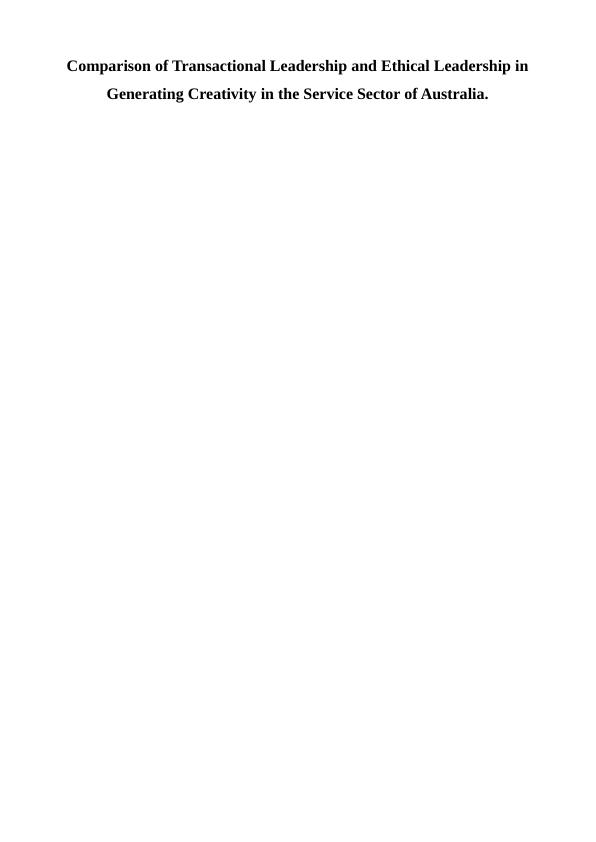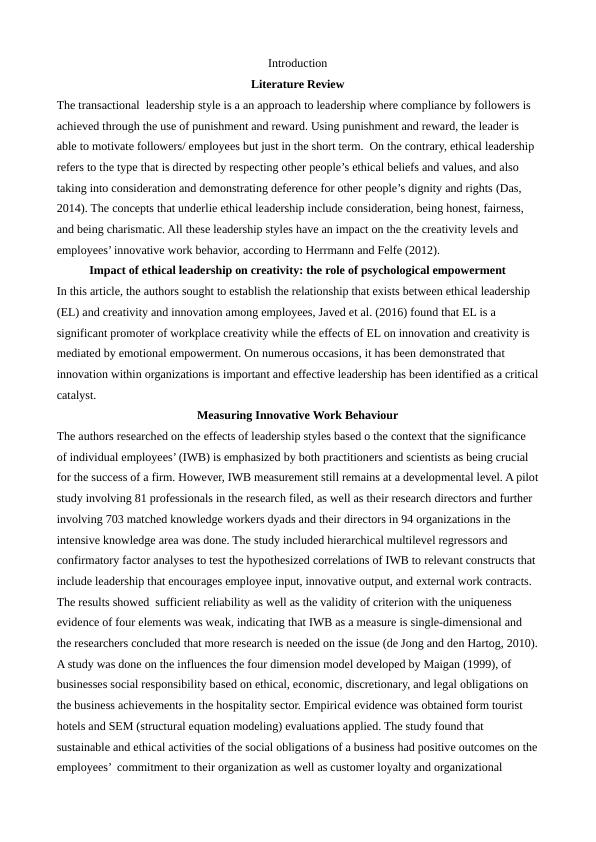Comparison of Transactional Leadership and Ethical Leadership in Generating Creativity in the Service Sector of Australia
Added on 2022-11-16
7 Pages2325 Words76 Views
Comparison of Transactional Leadership and Ethical Leadership in
Generating Creativity in the Service Sector of Australia.
Generating Creativity in the Service Sector of Australia.

Introduction
Literature Review
The transactional leadership style is a an approach to leadership where compliance by followers is
achieved through the use of punishment and reward. Using punishment and reward, the leader is
able to motivate followers/ employees but just in the short term. On the contrary, ethical leadership
refers to the type that is directed by respecting other people’s ethical beliefs and values, and also
taking into consideration and demonstrating deference for other people’s dignity and rights (Das,
2014). The concepts that underlie ethical leadership include consideration, being honest, fairness,
and being charismatic. All these leadership styles have an impact on the the creativity levels and
employees’ innovative work behavior, according to Herrmann and Felfe (2012).
Impact of ethical leadership on creativity: the role of psychological empowerment
In this article, the authors sought to establish the relationship that exists between ethical leadership
(EL) and creativity and innovation among employees, Javed et al. (2016) found that EL is a
significant promoter of workplace creativity while the effects of EL on innovation and creativity is
mediated by emotional empowerment. On numerous occasions, it has been demonstrated that
innovation within organizations is important and effective leadership has been identified as a critical
catalyst.
Measuring Innovative Work Behaviour
The authors researched on the effects of leadership styles based o the context that the significance
of individual employees’ (IWB) is emphasized by both practitioners and scientists as being crucial
for the success of a firm. However, IWB measurement still remains at a developmental level. A pilot
study involving 81 professionals in the research filed, as well as their research directors and further
involving 703 matched knowledge workers dyads and their directors in 94 organizations in the
intensive knowledge area was done. The study included hierarchical multilevel regressors and
confirmatory factor analyses to test the hypothesized correlations of IWB to relevant constructs that
include leadership that encourages employee input, innovative output, and external work contracts.
The results showed sufficient reliability as well as the validity of criterion with the uniqueness
evidence of four elements was weak, indicating that IWB as a measure is single-dimensional and
the researchers concluded that more research is needed on the issue (de Jong and den Hartog, 2010).
A study was done on the influences the four dimension model developed by Maigan (1999), of
businesses social responsibility based on ethical, economic, discretionary, and legal obligations on
the business achievements in the hospitality sector. Empirical evidence was obtained form tourist
hotels and SEM (structural equation modeling) evaluations applied. The study found that
sustainable and ethical activities of the social obligations of a business had positive outcomes on the
employees’ commitment to their organization as well as customer loyalty and organizational
Literature Review
The transactional leadership style is a an approach to leadership where compliance by followers is
achieved through the use of punishment and reward. Using punishment and reward, the leader is
able to motivate followers/ employees but just in the short term. On the contrary, ethical leadership
refers to the type that is directed by respecting other people’s ethical beliefs and values, and also
taking into consideration and demonstrating deference for other people’s dignity and rights (Das,
2014). The concepts that underlie ethical leadership include consideration, being honest, fairness,
and being charismatic. All these leadership styles have an impact on the the creativity levels and
employees’ innovative work behavior, according to Herrmann and Felfe (2012).
Impact of ethical leadership on creativity: the role of psychological empowerment
In this article, the authors sought to establish the relationship that exists between ethical leadership
(EL) and creativity and innovation among employees, Javed et al. (2016) found that EL is a
significant promoter of workplace creativity while the effects of EL on innovation and creativity is
mediated by emotional empowerment. On numerous occasions, it has been demonstrated that
innovation within organizations is important and effective leadership has been identified as a critical
catalyst.
Measuring Innovative Work Behaviour
The authors researched on the effects of leadership styles based o the context that the significance
of individual employees’ (IWB) is emphasized by both practitioners and scientists as being crucial
for the success of a firm. However, IWB measurement still remains at a developmental level. A pilot
study involving 81 professionals in the research filed, as well as their research directors and further
involving 703 matched knowledge workers dyads and their directors in 94 organizations in the
intensive knowledge area was done. The study included hierarchical multilevel regressors and
confirmatory factor analyses to test the hypothesized correlations of IWB to relevant constructs that
include leadership that encourages employee input, innovative output, and external work contracts.
The results showed sufficient reliability as well as the validity of criterion with the uniqueness
evidence of four elements was weak, indicating that IWB as a measure is single-dimensional and
the researchers concluded that more research is needed on the issue (de Jong and den Hartog, 2010).
A study was done on the influences the four dimension model developed by Maigan (1999), of
businesses social responsibility based on ethical, economic, discretionary, and legal obligations on
the business achievements in the hospitality sector. Empirical evidence was obtained form tourist
hotels and SEM (structural equation modeling) evaluations applied. The study found that
sustainable and ethical activities of the social obligations of a business had positive outcomes on the
employees’ commitment to their organization as well as customer loyalty and organizational

innovation and these all had positive consequences on business performance. The research also
found that corporate citizenship is indirectly correlated to positive business outcomes in a positive
manner via the moderating roles of perceptual commitment to an organization, customer loyalty,
and innovativeness.
Motivated or Demotivated to Be Creative: The Role of Self‐Regulatory Focus in
Transformational and Transactional Leadership Processes
Active transactional leadership, according to this experimental research, is a significant causative
factor in the hindrance of employee creativity by leaders due to its alignment with followers/
employees’ prevention of situational self regulation focus. The research was conducted using an
experimental study with 189 participants and a filed study involving 75 managers and 343
employees. The study also shows that there is a complex relationship than previously thought,
between different leadership styles and innovation and creativity
Leadership, creativity, and innovation: A critical review and practical recommendations
Among the key predictors of team, employee, and organizational innovation and creativity if
leadership and there is promise for great research in this field. In this paper, the authors performed
an extensive review of empirical studies (number N = 195) studying innovation and workplace
creativity and its relation to leadership. The paper performed several systematic analyses that were
used to develop narratives based on observations made in the review in five thematic areas. The
analysis established that positive leadership approaches such as ethical leadership had a strong and
positive correlation with creativity and innovation at the workplace. The researchers coded the
studies for factors such as correlation coefficients, sample size, and reliability. Using meta-analytic
procedures that corrected correlations among observations, the analysis showed that there is a
positive correlation between ethical leadership and ethical context perceptions among the
employees with p=0.56. It was also found that there was positive relationship between ethical
leadership behaviors and employee creativity and self initiative with p=0.44. Further, the meta
analysis established that there was positive strong relationship between ethical leadership behaviors
and IWB among the followers (employees) with p= 0.78. It was also determined that there was a
positive and strong relation between ethical leadership behaviors and dimensions of contingent
reward with p= 0.82.
The relationships between various constructs in follower actions and responses with other forms of
leadership styles, notably transactional leadership and transformational leadership were also
evaluated. The relationship between abusive leadership behavior and perceptions of ethics had a
negative but moderate relationship with p= 0.54. There was a weak puts positive relationship
between punishing behaviors associated with transactional leadership and follower creativity and
self initiative with p= 0.22. the relationship between rewarding behaviors, also associated with
found that corporate citizenship is indirectly correlated to positive business outcomes in a positive
manner via the moderating roles of perceptual commitment to an organization, customer loyalty,
and innovativeness.
Motivated or Demotivated to Be Creative: The Role of Self‐Regulatory Focus in
Transformational and Transactional Leadership Processes
Active transactional leadership, according to this experimental research, is a significant causative
factor in the hindrance of employee creativity by leaders due to its alignment with followers/
employees’ prevention of situational self regulation focus. The research was conducted using an
experimental study with 189 participants and a filed study involving 75 managers and 343
employees. The study also shows that there is a complex relationship than previously thought,
between different leadership styles and innovation and creativity
Leadership, creativity, and innovation: A critical review and practical recommendations
Among the key predictors of team, employee, and organizational innovation and creativity if
leadership and there is promise for great research in this field. In this paper, the authors performed
an extensive review of empirical studies (number N = 195) studying innovation and workplace
creativity and its relation to leadership. The paper performed several systematic analyses that were
used to develop narratives based on observations made in the review in five thematic areas. The
analysis established that positive leadership approaches such as ethical leadership had a strong and
positive correlation with creativity and innovation at the workplace. The researchers coded the
studies for factors such as correlation coefficients, sample size, and reliability. Using meta-analytic
procedures that corrected correlations among observations, the analysis showed that there is a
positive correlation between ethical leadership and ethical context perceptions among the
employees with p=0.56. It was also found that there was positive relationship between ethical
leadership behaviors and employee creativity and self initiative with p=0.44. Further, the meta
analysis established that there was positive strong relationship between ethical leadership behaviors
and IWB among the followers (employees) with p= 0.78. It was also determined that there was a
positive and strong relation between ethical leadership behaviors and dimensions of contingent
reward with p= 0.82.
The relationships between various constructs in follower actions and responses with other forms of
leadership styles, notably transactional leadership and transformational leadership were also
evaluated. The relationship between abusive leadership behavior and perceptions of ethics had a
negative but moderate relationship with p= 0.54. There was a weak puts positive relationship
between punishing behaviors associated with transactional leadership and follower creativity and
self initiative with p= 0.22. the relationship between rewarding behaviors, also associated with

End of preview
Want to access all the pages? Upload your documents or become a member.
Related Documents
Leadership styles and empowerment with nurses’ organizational commitment in acute health care settinglg...
|10
|8542
|470
Business leadership.lg...
|21
|496
|8
Leadership Skills - Assignmentlg...
|18
|3805
|48
The Role of Leadership in Stimulating Innovation in UK Retail Banking Sectorlg...
|12
|3768
|194
Personal Leadership Ghosn | Case Studylg...
|5
|964
|124
Leadership in Businesslg...
|16
|3315
|44
